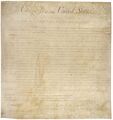Template:Selected anniversaries/June 8: Difference between revisions
No edit summary |
No edit summary |
||
| Line 3: | Line 3: | ||
File:Giovanni_Cassini.jpg|link=Giovanni Domenico Cassini (nonfiction)|1625: Mathematician, astronomer, and engineer [[Giovanni Domenico Cassini (nonfiction)|Giovanni Domenico Cassini]] born. He will discover four satellites of the planet Saturn and note the division of the rings of Saturn; the Cassini Division will be named after him. | File:Giovanni_Cassini.jpg|link=Giovanni Domenico Cassini (nonfiction)|1625: Mathematician, astronomer, and engineer [[Giovanni Domenico Cassini (nonfiction)|Giovanni Domenico Cassini]] born. He will discover four satellites of the planet Saturn and note the division of the rings of Saturn; the Cassini Division will be named after him. | ||
||1724 | ||1724: John Smeaton born ... engineer, designed the Coldstream Bridge and Perth Bridge. | ||
||1745 | ||1745: Caspar Wessel born ... mathematician and cartographer. | ||
File:Bill of Rights.jpg|link=United States Bill of Rights (nonfiction)|1789: James Madison introduces nine amendments to the constitution in the House of Representatives, inluencing later [[United States Bill of Rights (nonfiction)|Bill of Rights]] amendments. | File:Bill of Rights.jpg|link=United States Bill of Rights (nonfiction)|1789: James Madison introduces nine amendments to the constitution in the House of Representatives, inluencing later [[United States Bill of Rights (nonfiction)|Bill of Rights]] amendments. | ||
||1794 | ||1794: Robespierre inaugurates the French Revolution's new state religion, the Cult of the Supreme Being, with large organized festivals all across France. | ||
File:Thomas Paine.jpg|link=Thomas Paine (nonfiction)|1809: [[Thomas Paine (nonfiction)|Thomas Paine]] dies. He authored the two most influential pamphlets at the start of the American Revolution, and inspired the rebels in 1776 to declare independence from Britain. | File:Thomas Paine.jpg|link=Thomas Paine (nonfiction)|1809: [[Thomas Paine (nonfiction)|Thomas Paine]] dies. He authored the two most influential pamphlets at the start of the American Revolution, and inspired the rebels in 1776 to declare independence from Britain. | ||
||Jacques-Arsène d'Arsonval | ||1851: Jacques-Arsène d'Arsonval born ... physician, physicist, and inventor of the moving-coil D'Arsonval galvanometer and the thermocouple ammeter. D'Arsonval was an important contributor to the emerging field of electrophysiology, the study of the effects of electricity on biological organisms, in the nineteenth century. | ||
||1860 | ||1860: Alicia Boole Stott born ... mathematician and theorist. | ||
||1867 | ||1867: Frank Lloyd Wright born ... architect, designed the Price Tower and Fallingwater. | ||
||1887 | File:Herman Hollerith.jpg|link=Herman Hollerith (nonfiction)|1887: Inventor [[Herman Hollerith (nonfiction)|Herman Hollerith]] applies for US patent #395,781 for the 'Art of Compiling Statistics', his punched card calculator. | ||
||Ernst-Robert Grawitz | ||1899: Ernst-Robert Grawitz born ... physician and an SS functionary (Reichsarzt, "arzt" meaning "physician") during the Nazi era. | ||
||1897 | ||1897: John G. Bennett born ... mathematician and technologist. | ||
||1910 | ||1910: C. C. Beck born ... illustrator ... comics. | ||
File:Emmy Noether.jpg|link=Emmy Noether (nonfiction)|1912: Mathematician [[Emmy Noether (nonfiction)|Emmy Noether]] uses [[Gnomon algorithm]] techniques to detect and prevent [[crimes against mathematical constants]]. | File:Emmy Noether.jpg|link=Emmy Noether (nonfiction)|1912: Mathematician [[Emmy Noether (nonfiction)|Emmy Noether]] uses [[Gnomon algorithm]] techniques to detect and prevent [[crimes against mathematical constants]]. | ||
||1916 | ||1916: Francis Crick born ... biologist, biophysicist, and neuroscientist, Nobel Prize laureate. | ||
||1918 | ||1918: John D. Roberts born ... chemist and academic. | ||
|| | ||1920: Augusto Righi dies ... physicist and a pioneer in the study of electromagnetism. Pic. | ||
|| | ||1930: Robert Aumann, German-American mathematician and economist, Nobel Prize laureate (alive August 2018). | ||
||Robert W (Bob) Floyd | ||1936: Kenneth G. Wilson born ... physicist and academic, Nobel Prize laureate. | ||
||1936: Robert W (Bob) Floyd born ... computer scientist. His contributions include the design of the Floyd–Warshall algorithm (independently of Stephen Warshall), which efficiently finds all shortest paths in a graph, Floyd's cycle-finding algorithm for detecting cycles in a sequence, and his work on parsing. In one isolated paper he introduced the important concept of error diffusion for rendering images, also called Floyd–Steinberg dithering (though he distinguished dithering from diffusion). A significant achievement was pioneering the field of program verification using logical assertions with the 1967 paper Assigning Meanings to Programs. This was an important contribution to what later became Hoare logic. | |||
||1942 – World War II: The Japanese imperial submarines I-21 and I-24 shell the Australian cities of Sydney and Newcastle. | ||1942 – World War II: The Japanese imperial submarines I-21 and I-24 shell the Australian cities of Sydney and Newcastle. | ||
Revision as of 08:46, 26 August 2018
1625: Mathematician, astronomer, and engineer Giovanni Domenico Cassini born. He will discover four satellites of the planet Saturn and note the division of the rings of Saturn; the Cassini Division will be named after him.
1789: James Madison introduces nine amendments to the constitution in the House of Representatives, inluencing later Bill of Rights amendments.
1809: Thomas Paine dies. He authored the two most influential pamphlets at the start of the American Revolution, and inspired the rebels in 1776 to declare independence from Britain.
1887: Inventor Herman Hollerith applies for US patent #395,781 for the 'Art of Compiling Statistics', his punched card calculator.
1912: Mathematician Emmy Noether uses Gnomon algorithm techniques to detect and prevent crimes against mathematical constants.
1955: Engineer and computer scientist Tim Berners-Lee born. He will invent the World Wide Web.





